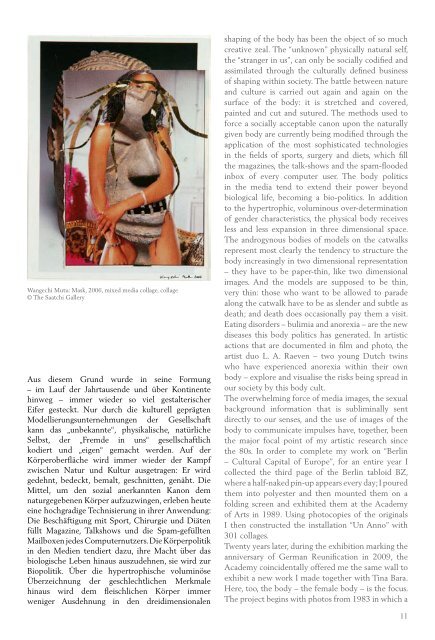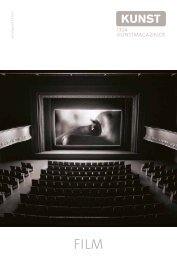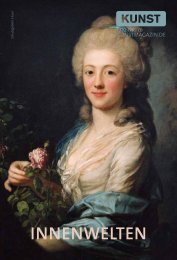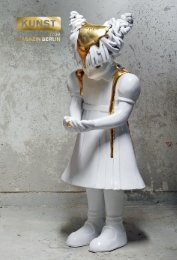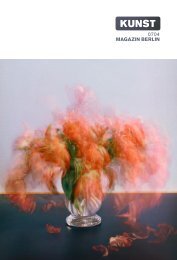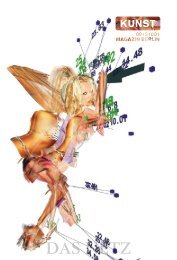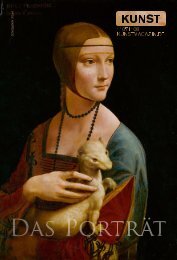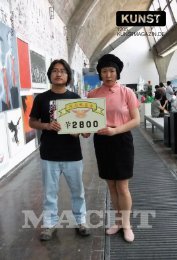Die Berliner Sammlung Dr. Carl Theodor Gottlob ... - KUNST Magazin
Die Berliner Sammlung Dr. Carl Theodor Gottlob ... - KUNST Magazin
Die Berliner Sammlung Dr. Carl Theodor Gottlob ... - KUNST Magazin
Sie wollen auch ein ePaper? Erhöhen Sie die Reichweite Ihrer Titel.
YUMPU macht aus Druck-PDFs automatisch weboptimierte ePaper, die Google liebt.
Wangechi Mutu: Mask, 006, mixed media collage, collage<br />
© The Saatchi Gallery<br />
Aus diesem Grund wurde in seine Formung<br />
– im Lauf der Jahrtausende und über Kontinente<br />
hinweg – immer wieder so viel gestalterischer<br />
Eifer gesteckt. Nur durch die kulturell geprägten<br />
Modellierungsunternehmungen der Gesellschaft<br />
kann das „unbekannte“, physikalische, natürliche<br />
Selbst, der „Fremde in uns“ gesellschaftlich<br />
kodiert und „eigen“ gemacht werden. Auf der<br />
Körperoberfläche wird immer wieder der Kampf<br />
zwischen Natur und Kultur ausgetragen: Er wird<br />
gedehnt, bedeckt, bemalt, geschnitten, genäht. <strong>Die</strong><br />
Mittel, um den sozial anerkannten Kanon dem<br />
naturgegebenen Körper aufzuzwingen, erleben heute<br />
eine hochgradige Technisierung in ihrer Anwendung:<br />
<strong>Die</strong> Beschäftigung mit Sport, Chirurgie und Diäten<br />
füllt <strong>Magazin</strong>e, Talkshows und die Spam-gefüllten<br />
Mailboxen jedes Computernutzers. <strong>Die</strong> Körperpolitik<br />
in den Medien tendiert dazu, ihre Macht über das<br />
biologische Leben hinaus auszudehnen, sie wird zur<br />
Biopolitik. Über die hypertrophische voluminöse<br />
Überzeichnung der geschlechtlichen Merkmale<br />
hinaus wird dem fleischlichen Körper immer<br />
weniger Ausdehnung in den dreidimensionalen<br />
shaping of the body has been the object of so much<br />
creative zeal. The “unknown” physically natural self,<br />
the “stranger in us”, can only be socially codified and<br />
assimilated through the culturally defined business<br />
of shaping within society. The battle between nature<br />
and culture is carried out again and again on the<br />
surface of the body: it is stretched and covered,<br />
painted and cut and sutured. The methods used to<br />
force a socially acceptable canon upon the naturally<br />
given body are currently being modified through the<br />
application of the most sophisticated technologies<br />
in the fields of sports, surgery and diets, which fill<br />
the magazines, the talk-shows and the spam-flooded<br />
inbox of every computer user. The body politics<br />
in the media tend to extend their power beyond<br />
biological life, becoming a bio-politics. In addition<br />
to the hypertrophic, voluminous over-determination<br />
of gender characteristics, the physical body receives<br />
less and less expansion in three dimensional space.<br />
The androgynous bodies of models on the catwalks<br />
represent most clearly the tendency to structure the<br />
body increasingly in two dimensional representation<br />
– they have to be paper-thin, like two dimensional<br />
images. And the models are supposed to be thin,<br />
very thin: those who want to be allowed to parade<br />
along the catwalk have to be as slender and subtle as<br />
death; and death does occasionally pay them a visit.<br />
Eating disorders – bulimia and anorexia – are the new<br />
diseases this body politics has generated. In artistic<br />
actions that are documented in film and photo, the<br />
artist duo L. A. Raeven – two young Dutch twins<br />
who have experienced anorexia within their own<br />
body – explore and visualise the risks being spread in<br />
our society by this body cult.<br />
The overwhelming force of media images, the sexual<br />
background information that is subliminally sent<br />
directly to our senses, and the use of images of the<br />
body to communicate impulses have, together, been<br />
the major focal point of my artistic research since<br />
the 0s. In order to complete my work on “Berlin<br />
– Cultural Capital of Europe”, for an entire year I<br />
collected the third page of the Berlin tabloid BZ,<br />
where a half-naked pin-up appears every day; I poured<br />
them into polyester and then mounted them on a<br />
folding screen and exhibited them at the Academy<br />
of Arts in . Using photocopies of the originals<br />
I then constructed the installation “Un Anno” with<br />
0 collages.<br />
Twenty years later, during the exhibition marking the<br />
anniversary of German Reunification in 00 , the<br />
Academy coincidentally offered me the same wall to<br />
exhibit a new work I made together with Tina Bara.<br />
Here, too, the body – the female body – is the focus.<br />
The project begins with photos from in which a


